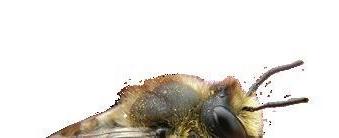
4 minute read
Progress so far
Success in protecting our pollinators can be measured in the short, medium, and long-term. In the short-term, success lies in delivering a cohesive all-island strategy. In the medium-term, it is the actions on the ground that change the way we manage our environment to provide pollinators with the food and shelter they need to survive. In the long-term, success will mean a diverse pollinator assemblage across the landscape that is healthy and sustainable.
In publishing the All-Ireland Pollinator Plan in September 2015, Ireland became one of the first countries in Europe to address the problem of pollinator declines. The initial Plan was developed from the ground up and evolved into a widespread and successful biodiversity initiative that has a large public profile.
Advertisement
The first phase of the AIPP achieved widescale buy-in, with more than 100 governmental and non-governmental organisations agreeing their support. It was a proven example of effective North-South cooperation, with both jurisdictions coming together to work within a common framework.
The All-Ireland Pollinator Plan (2015-2020) has achieved considerable impact:
At the end of the five years, the 81 actions in the Plan have been delivered.
Across all sectors, the number of engaged individuals and organisations continues to increase.
Freely available, evidence-based resources, tailored by sector, have been developed. These have resulted in real engagement with the Plan in terms of actual and planned changes to land management.
The All-Ireland Pollinator Plan is internationally regarded as an example of best practice, and has been recommended as a template for the development of national pollinator strategies by EU Member States. A publicly available GIS-based mapping system has been developed by the National Biodiversity Data Centre to track what actions are being taken across sectors (Actions for Pollinators: https://pollinators. biodiversityireland.ie). It is the first system of its kind to track progress across multiple partners within a biodiversity plan. To date, more than 1,600 individual sites have logged more than 4,400 pollinator-friendly actions.
Building on the AIPP, the National Biodiversity Data Centre successfully secured €1,194,679 funding for a five-year project (2019-2023) on protecting farmland pollinators through the European Innovation Partnership (EIP) run by DAFM. This project is developing a framework by which all farms can become more pollinator friendly.
Already, 55% of Councils across the island have formally partnered with the Plan and agreed to take actions to help.
The Plan is supported by the four main Transport Authorities on the island, who endorsed evidence-based guidelines for pollinator-friendly management of transport corridors (2019).
A dedicated pollinator award in the Tidy Towns competition (organised and funded by the Local Authority Heritage and Biodiversity Officer network) has seen more than 160 local communities make their local areas more pollinator friendly.
278 businesses have signed up as Business Supporters and agreed to take action to help.
Increasing numbers of state and semi-state organisations have agreed to manage their networks of sites for pollinators.
Resources have been developed for schools (Junior Pollinator Plan, How-to-guide on developing a school pollinator plan) and the Plan has been incorporated into the GreenSchools and Green Campus initiatives. The AIPP partnered with SuperValu in 2020 on a large primary school education campaign, called ‘Save the Bees’. An Education Pack was sent to 3,200 primary schools, with over half a million children.
Many third level institutions have created their own Pollinator Plans and are implementing pollinator-friendly measures on campuses.
Work has taken place to raise awareness and establish initiatives to help the Great Yellow Bumblebee, the most threatened bumblebee on the island of Ireland.
All beekeeping associations, as well as the Native Irish Honeybee Society, have engaged with and supported the Plan during its first phase.
The number of researchers working on pollinators has increased, and an Irish Pollinator Research Network has been established. The network meets annually to ensure collaboration, cohesion and that the evidence-base for policy and action is improved.
There has been a significant increase in the number of people accessing pollinator identification resources and submitting data on wild bees and hoverflies to the National Biodiversity Data Centre and CEDaR. A recent online poll (Trinity College Dublin, 2020) found AIPP participants to be knowledgeable about pollinators and to have positive attitudes towards them. The top three sectors that engaged with the Plan were individuals, businesses and community organisations. This aligned with the first set of tailored sectoral guidelines released by the AIPP, showing the importance of bespoke information for engagement.
The first phase of the Plan has been successfully delivered and has started a process of widespread change to land management to better support pollinators and other biodiversity. The success of the Plan in reversing declines cannot yet realistically be assessed. Assuming food and shelter can continue to be returned to the landscape through the AIPP, we would expect to begin to see positive impacts on wild pollinator abundances over the next decade. Only one scientifically rigorous monitoring scheme is currently in place. The All-Ireland Bumblebee Monitoring Scheme is a citizen science initiative that was established by the National Biodiversity Data Centre in 2012. The timing of the development and publication of the AIPP in 2015 was linked to this scheme so that some baseline data would be in place before implementation.

Megachile centuncularis © Steven Falk










